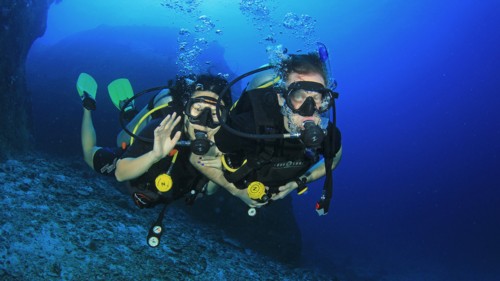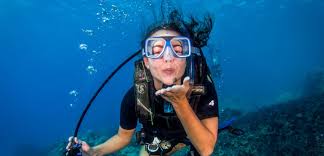

 Online Scuba Lessons |
 Online Nitrox Lessons |



Can We Talk ...?
Underwater
Hand Signals
Unless one is well versed in the art of sign language, diving can be a very frustrating activity when a pair of scuba divers - or more - can't communicate. Just as we should periodically refresh our skills in diving, we should not forget our only reliable and universal way of speaking underwater - the diver's hand signals. Did you know that NAUI developed the Diving Hand Signals which are taught and used throughout the US, and most of the world?
It's obvious why we must communicate underwater - no matter how detailed our dive plan is, things change. The weather, visibility, injury or illness, and marine life all can be unpredictable. We have to be able to change our dive plan, and make it clear without the luxury of popping to the surface for a chat. Even at the surface, speech can be ineffective. In the right conditions, even shouting cannot be heard over the water where normally it would not be a problem on land. Flags or whistles are also used on the surface, but the most frequent form of communication takes place under the surface where divers are out of earshot or visual contact of the boat.
There are many slates and writing devices on the market today, some of which can be quite effective. But if you're like me, I'm usually burdened already by lights, cameras and other goodies, and the slate usually ends up sitting out the dive, in my gear bag. And have you ever tried to practice perfect penmanship in a current when you're trying to tell your buddy there is the biggest bleeping so-and-so tiger shark you have ever seen smelling his left fin? It's so hard to stay composed for that long, when a simple two-hands-making-a-point-on-your-head gesture would have served quite well!
All joking aside, gadgets are great but they're no substitute for good training! Most hand signals serve a much more conventional purpose, and should be carried out in a calm, methodical way. But you will soon create confusion and probably lose your buddy's attention if you can't get the message across. Just as you have been trained to make a dive plan, discuss hand signals with each new dive buddy and get a feel for the extent of his or her knowledge. Then, if needs be, educate him or her as to the signals they should know.
There are twelve "official" signals, and a few unofficial ones that all divers seem to use, and it can be fun to explore this new form of conversation. Practice it on the surface. Test each other. Play games with it. Soon you will be amazed at how much you can say without uttering a sound!
The most frequently used and generally first learned is the "OK" signal. It can be a question or an answer. So, when someone gives you the OK, it's not because you look great in your hot pink dive skin, it's because he needs to know how you're doing! Answer quickly with a hearty OK back, and he will continue with the dive. If you hesitate, or give the Unofficial "I Don't Know Nuthin" shrug, he's gonna get worried and try to help you, even if you don't need it. Here's a common mistake: Your buddy gives you the "OK?" question/signal, and you respond with a Hearty Thumb's-Up instead of the Thumb-Touching-Pointer-Finger OK sign. He rushes over and grabs you, pulling you down to the sand like it's the last 3 seconds of overtime in the Superbowl and you've got the ball.
You see, you have just mistakenly given him the "I need to go up" sign instead of the OK sign, and he was only trying to keep you from popping to the surface! One simple example of how it helps to know what you're talking about down there! As you can imagine, the confusion can become quite serious in a crisis!
Here's the proper procedure to engage in conversation underwater. Swim up beside the diver you want to talk to, and gently touch him or her, so that he/she can tell it's a touch and not something else! You can really make someone lose their composure by grabbing a fin or clamping down on their arm if they don't know you're there! Make Eye Contact! Give the hand signal clearly, point at the person if you want them to know it is intended for them. Wait for a response. The diver should acknowledge by giving you the SAME signal back, and/or the OK sign (not the thumbs-up please!) and then he should follow your instruction. If he doesn't, get his attention again and repeat. If there is danger involved, give him the danger sign, so he knows you're not fooling around. If he doesn't know what you want, you may have to show him, or take matters into your own hands, but at least you have done the responsible thing by communicating your wishes or your actions properly. Then when you get to the surface give him or her a copy of this article! (Just Kidding).
Having made my point, let's try a little brain exercise. Here are the twelve Official Diving Hand Signals, and a few of the common ones divers use - see if you know them:
The Official Ones:
1. OK!/OK?
2. STOP
3. GO UP/GOING UP
4. GO/GOING DOWN
5. I'M OUT OF AIR
6. LET'S BUDDY BREATHE
7. DANGER
8. LOW ON AIR
9. HELP! (ON THE SURFACE)
10. OK (ON THE SURFACE)
11. HOW MUCH AIR DO YOU HAVE?
12. PICK ME UP (SURFACE)
And some of my personal favorites:
13. SHARK
14. I'LL LEAD, YOU FOLLOW
15. EAR OR SINUS SQUEEZE
16. I DON'T UNDERSTAND
17. DIZZY!
18. FEEL SICK
19. LOOK
20. LISTEN
How did you do? If you weren't too sure of the
first twelve, then you need to refresh your skills! Now test
your buddy. Remember, this is just an exercise, so put
that ego away! If neither one of you know the signals,
we've got to talk!
Dive safe and "talk" to each other...
Bwana
![]()